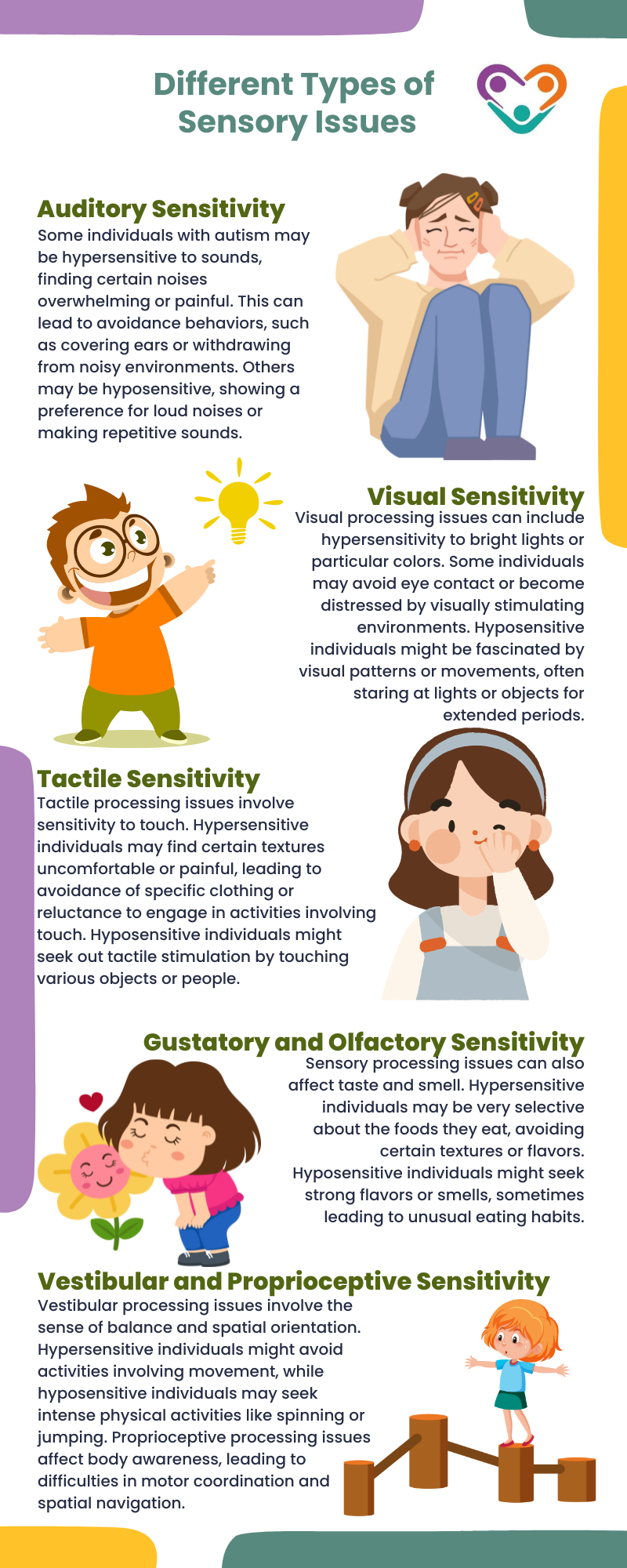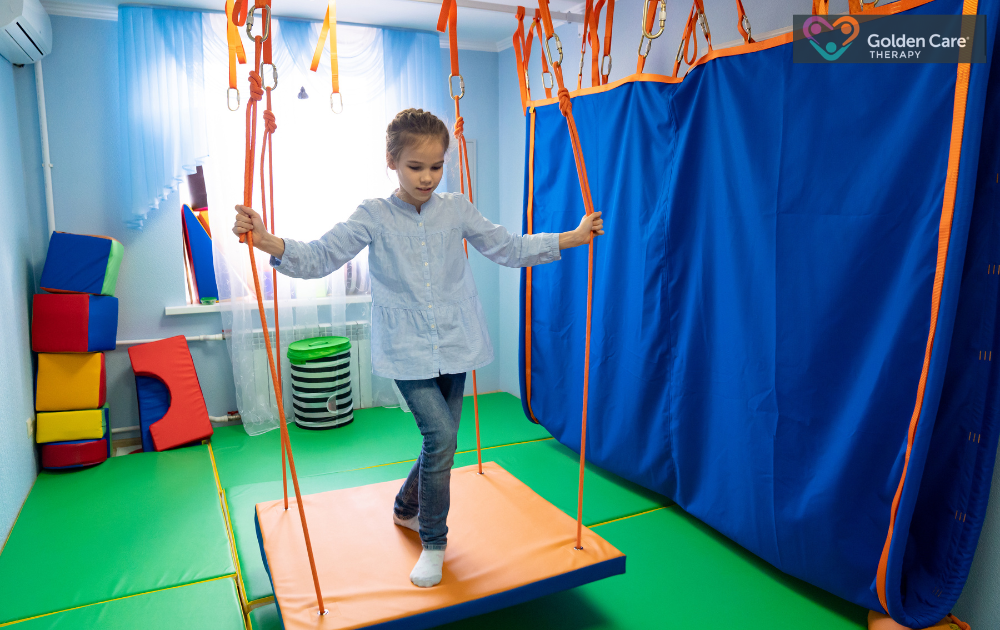One of the core aspects of autism that has gained significant attention in recent years is sensory processing issues. These sensory issues can manifest in various ways and are often among the first signs that lead parents and caregivers to seek an autism diagnosis for their children.
Learning the nature of these sensory issues, how they relate to autism, and what current research suggests can help provide valuable insights for those affected by or working with individuals on the autism spectrum.

What Are Sensory Issues?
Sensory issues, also known as sensory processing difficulties, refer to the way the nervous system receives messages from the senses and turns them into appropriate motor and behavioral responses. Individuals with sensory processing issues might be overly sensitive (hypersensitive) or under-sensitive (hyposensitive) to sensory stimuli.
This means they may have unusual reactions to things like lights, sounds, textures, tastes, and smells.
For example, a child hypersensitive to sound might cover their ears and become distressed by loud noises that others find tolerable. Conversely, a child who is hyposensitive might seek out sensory stimulation by making loud noises or touching everything in their environment.
Are Sensory Issues a Sign of Autism?
Yes, sensory issues are commonly associated with autism, and research indicates that a significant percentage of individuals with autism experience sensory processing difficulties.
According to the Diagnostic and Statistical Manual of Mental Disorders, Fifth Edition (DSM-5), unusual sensory responses are included as part of the criteria for diagnosing autism. The DSM-5 notes that individuals with autism might have hyper- or hyporeactivity to sensory input or unusual interest in sensory aspects of the environment.
Studies have shown that sensory processing issues are prevalent in individuals with autism. A study found that 95% of children with autism demonstrated some form of sensory processing difficulty. These difficulties can significantly impact daily functioning and quality of life, influencing behavior, communication, and learning.
The Different Types of Sensory Issues
Sensory issues in autism can be categorized into different types based on the sensory systems involved. These include the following:

Research on Sensory Issues and Autism
Extensive research has been conducted to understand the relationship between sensory issues and autism. Studies suggest that sensory processing difficulties are a core feature of autism, and they can significantly affect an individual’s behavior, communication, and social interactions.
A study highlighted the prevalence and severity of sensory processing issues in children with autism compared to typically developing children. The study found that children with autism exhibited significantly higher levels of sensory over-responsivity and under-responsivity.
These sensory issues were associated with greater levels of anxiety, social difficulties, and behavioral problems.
Another study explored the relationship between sensory processing issues and repetitive behaviors in autism. The researchers found that sensory processing difficulties were strongly correlated with the presence of repetitive behaviors, suggesting that sensory issues might drive these behaviors as a coping mechanism.
Further research examined the neurological basis of sensory processing issues in autism. The study used neuroimaging techniques to identify differences in brain structure and function related to sensory processing in individuals with autism. The findings indicated that atypical brain connectivity might underlie sensory processing difficulties, contributing to the sensory experiences of individuals with autism.

Impact of Sensory Issues on Daily Life
Sensory processing issues can have a profound impact on the daily lives of individuals with autism and their families. These issues can affect various aspects of life, including:
- Communication: Sensory issues can interfere with communication. For example, hypersensitivity to sound might make it difficult for an individual to focus on spoken language, leading to misunderstandings or difficulty following conversations. Hyposensitivity might result in a lack of awareness of social cues or difficulty modulating vocal volume.
- Social Interaction: Sensory issues can also affect social interactions. Hypersensitivity to touch or sound might lead to avoidance of social situations, while hyposensitivity might result in behaviors that others find unusual or disruptive. These difficulties can contribute to social isolation and challenges in forming relationships.
- Learning and Development: Sensory processing difficulties can impact learning and development. For example, hypersensitivity to visual or auditory stimuli in a classroom setting might make it difficult for a child to concentrate on lessons. Hyposensitivity might lead to seeking out sensory stimulation rather than engaging in structured activities.
- Behavior: Sensory issues can contribute to challenging behaviors. Hypersensitivity might result in meltdowns or tantrums in response to overwhelming sensory input. Hyposensitivity might lead to seeking out sensory experiences in ways that are unsafe or disruptive.
Strategies for Managing Sensory Issues
Managing sensory issues in individuals with autism requires a comprehensive and individualized approach.
Sensory integration therapy involves structured activities designed to help individuals process sensory information more effectively. Occupational therapists often use this approach to help individuals with autism develop better sensory processing skills.
Creating a sensory-friendly environment can also help manage sensory issues. This might involve reducing sensory stimuli in the home or classroom, using noise-canceling headphones, or providing sensory breaks to help individuals regulate their sensory experiences.
Behavioral interventions can help individuals with autism develop coping strategies for managing sensory issues. This might include teaching relaxation techniques, using visual supports, or implementing routines to provide predictability.
Lastly, educating parents and caregivers about sensory processing issues and effective management strategies is crucial. Understanding the nature of sensory issues can help caregivers provide better support and advocate for their child’s needs.

The Role of Sensory Diets
One effective approach to managing sensory issues in autism is the implementation of a sensory diet. A sensory diet is a personalized plan of physical activities and accommodations designed to meet the sensory needs of an individual.
This concept, developed by occupational therapist Patricia Wilbarger, involves a variety of sensory experiences that are incorporated into daily routines to help individuals maintain an optimal level of arousal and focus.
For example, a sensory diet might include activities such as swinging, jumping, or using a weighted blanket to provide proprioceptive input. It might also involve scheduled breaks for quiet time in a sensory-friendly space or the use of sensory tools like fidget toys.
The goal of a sensory diet is to help individuals with autism achieve better sensory regulation, thereby improving their ability to participate in everyday activities and reducing the likelihood of sensory overload.
The Impact of Early Intervention
Early intervention is critical in addressing sensory processing difficulties in children with autism. Research has shown that early, targeted interventions can significantly improve sensory processing and related behaviors.
For instance, the Early Start Denver Model (ESDM) is an evidence-based intervention that incorporates sensory integration techniques to support the development of young children with autism. Studies have demonstrated that children who receive ESDM show significant improvements in sensory processing, social communication, and adaptive behaviors compared to those who do not receive such early interventions.
Early intervention programs often involve a multidisciplinary team, including occupational therapists, speech therapists, and special education teachers, working together to create a comprehensive and individualized treatment plan. These programs aim to address sensory issues in the context of the child’s overall development, promoting better outcomes across various domains.

The Importance of Sensory-Friendly Environments
Creating sensory-friendly environments is another crucial aspect of supporting individuals with autism. Sensory-friendly environments are designed to reduce sensory overload and provide a calming and predictable atmosphere.
This can be achieved through various modifications, such as controlling lighting and noise levels, using calming colors and textures, and providing spaces where individuals can retreat when they feel overwhelmed.
Many public spaces, including schools, museums, and recreational facilities, are now incorporating sensory-friendly features to accommodate individuals with autism. For example, some museums offer sensory-friendly hours with reduced lighting and noise, while schools might have sensory rooms equipped with various tools and activities to help students regulate their sensory input.
These efforts reflect a growing awareness and commitment to creating inclusive environments that support the diverse needs of individuals with autism.
Sensory issues are a significant and common feature of autism, affecting various aspects of life, including communication, social interaction, learning, and behavior. Understanding these sensory processing difficulties and their impact on individuals with autism is essential for providing effective support and interventions.
Research continues to shed light on the neurological basis of sensory issues in autism, offering hope for more targeted and effective therapies in the future. By recognizing and addressing sensory processing difficulties, we can improve the quality of life for individuals with autism and their families. If you’re seeking specialized ABA therapy in New Jersey, Indiana, Georgia, and New York, Golden Care offers comprehensive services tailored to meet the unique needs of each individual. Contact us to learn more or book a consultation today.
Sources:
https://childmind.org/article/sensory-processing-issues-explained
https://www.autismparentingmagazine.com/autism-sensory-processing-disorder



